.jpg)
Introduction
Storm and disaster restoration is a crucial process in the aftermath of natural disasters, such as storms, floods, fires, and hurricanes. It involves various steps and techniques for restoring properties to their pre-damaged condition.
Importance of Storm and Disaster Restoration
Effective storm and disaster restoration is essential for several reasons:
- Protecting Human Safety: Storm and disaster-damaged properties can pose hazards to occupants and nearby individuals. Restoration minimizes these risks and ensures a safe living or working environment.
- Preserving Property Value: Timely restoration mitigates further damage and preserves the value of the property. It prevents progressive deterioration and reduces repair costs.
- Recovering Essential Services: Restoration activities aim to restore essential services, such as water, electricity, and sanitation, to ensure that occupants can resume their daily lives.
- Community Rebuilding: Effective restoration contributes to community rebuilding efforts after a disaster. It helps revitalize affected areas and promotes economic recovery.
.jpg)
Debris Removal and Cleanup Process
The debris removal and cleanup process is a crucial component of storm and disaster restoration. It involves the systematic removal of debris and the cleaning of affected areas. Here are the key steps:
1. Safety Assessment and Planning
Prior to starting debris removal and cleanup, a thorough safety assessment is conducted to identify potential hazards, such as structural instability, contaminated materials, and electrical or gas hazards. A detailed plan is then developed to ensure the safety of restoration workers.
2. Debris Classification
Debris is classified into different categories, such as vegetative debris (tree branches, leaves), construction and demolition debris (building materials), and hazardous waste (chemicals, asbestos). This classification determines the handling and disposal methods.
3. Debris Removal
The debris removal process involves the systematic collection and transportation of debris to designated disposal sites. Depending on the volume and type of debris, specialized equipment, such as cranes, loaders, and trucks, may be used for efficient removal.
4. Site Cleanup
Once the debris is removed, the affected site undergoes thorough cleaning to remove residual dirt, dust, and contaminants. This may include pressure washing, surface disinfection, and mold remediation if necessary.
.jpg)
5. Salvage and Restoration
Salvageable items, such as furniture or equipment, are assessed for restoration. Depending on the extent of damage, professional restoration services may be employed to restore these items to their pre-damaged condition.
6. Environmental Considerations
During the debris removal and cleanup process, environmental considerations are crucial. Proper waste management and disposal practices are followed to minimize the impact on the environment. Recycling and reuse options are explored where applicable.
Relevant Resources
For more information on storm and disaster restoration, as well as related services, visit the following resources:
- Service Water Restoration Pros – Professional restoration services for water, fire, mold, and storm damage.
- Catastrophe Restoration – Coverage of the people, tools, and techniques related to catastrophe restoration.
- MasterCraft Disaster Restoration Comes to the Rescue – A heartwarming story about the impact of disaster restoration on a homeless shelter affected by flooding.
- Storm Damage | Tips, FAQ, Resources – Helpful resources on storm damage restoration tips, news, FAQs, and guides.
- Disaster Restoration: Importance & Types – Insights on the importance of disaster restoration and the various types of disasters.
- The Migrant Workers Who Follow Climate Disasters – An in-depth look at the laborers who assist in disaster recovery efforts.
- Flood Restoration and Hurricane Prep Tips – Useful tips for flood restoration and hurricane preparedness.
Frequently Asked Questions
What is storm and disaster restoration?
Why is debris removal and cleanup important in storm and disaster restoration?
What are the key steps in the debris removal and cleanup process?
For more frequently asked questions, visit our FAQ page.


